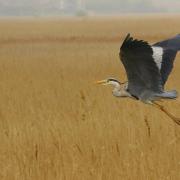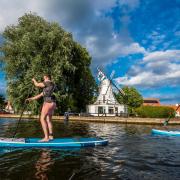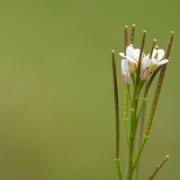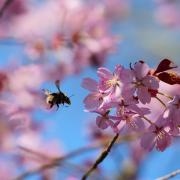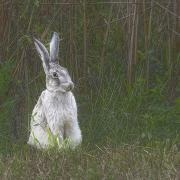West Norfolk Estate Wild Ken Hill is returning land to nature

A sprawling 4,000 acre estate on the edge of King’s Lynn in West Norfolk is perhaps not the place you’d expect to find a pair of beavers.
Yet that is exactly what you will find, if like me, you are lucky enough to be given a tour of Wild Ken Hill by Dominic Buscall, whose family have farmed there for generations. With their famously warm fur, protruding front teeth, and big flappy tails, these unassuming and characterful creatures (the beavers, that is) have a hugely important task before them.
Fenced into what is thought to be one of the biggest enclosures in England, they are the unwitting pioneers of an ambitious project to re-wild 1,000 acres of the estate. “They only came here back in March, but you can already see their impact. This 50-acre site is already much wetter, and that’s great news for biodiversity” says Dominic.
Despite the odd initial concern amongst locals over flooding, overall there has been an outpouring of support for the farm’s furry new friends. Described by Dominic as ‘ecosystem engineers’, the two females were brought in to help create precious wetland habitat.
“We wanted to prove that, managed effectively, beavers can bring great benefits, from mitigating flood risk to increasing species numbers.” A handful of small dams have already appeared, the numbers of which will rise as beaver numbers increase. Two males are set to be released next month, with a licence for up to 15.

In as little as five years Dominic expects to see big changes: “They will have turned all of this dark forest into an amazing wet and woody marshy swamp, stuffed full of animals. We are super-excited to see the transformation.”
As we clamber back into the farm’s green Land Rover and bump off down the track, the effects of the family’s progressive approach to farming are all around. Huge wild-flower borders surround the farms’ commercial crops, offering much-needed natural corridors for insects, butterflies, and birds, whilst poorly performing sandy fields are handed back to nature.
Grinding to a halt, the dull hum of insects fills the air. Wildflowers and grasses sway in the breeze, part of a patchwork of colour and scent. Some, like the Scarlet Pimpernel, provide food for the elusive turtle dove, whose solemn call has all but vanished from the British countryside.
The Buscalls have adopted a three-pronged approach to this environmentally-focused style of farming. First comes re-wilding, a process that lets nature take care of itself.
Dropping down into second we make our way up a steep and stony track, moving deeper into the heart of the estate. At the top, an impressive rust-coloured carrstone mansion stands like a stag in the centre of a glade. Around it, acid heathland thick with heather, gorse, and grass, is complemented by ancient oaks casting intricate shadows in the midday sun.

“As we introduce wild herbivores, this habitat will change and become much more open. Around 500 acres of the re-wilding site is presently woodland” says Dominic, “that will gradually move towards a wood pasture kind of environment, which is desirable because of its higher levels of biodiversity.” Grazing animals like pigs, cows, and horses are critical because they carry seeds in their fur, fertilise the land with their dung and help keep the forest clear by grazing saplings.
‘Wildlife photography saved me’
As we move into the commercially-farmed part of the estate, our conversation moves to regenerative farming. The focus here is on topsoil regeneration, increased biodiversity through reduced spraying and ploughing and water-cycle improvement. According to Buscall, richer, organically resilient soils help draw carbon out of the atmosphere and into the ground; a process known as sequestering.
‘We have seen a 60% decline in the abundance of some 214 priority species in the UK since 1970. I guess with modern commercial agricultural techniques, there has been an impact. Even the most die-hard conventional farmer might admit that.’
Farm manager Nick Padwick has been given the family’s backing to test, trial and experiment with new and innovative ways of farming. “Cover cropping, intercropping, minimum, and low till all help. ‘We’ve got some very fancy new drills and different bits of equipment” grins Dom.
When you invert or plough the soil, you release carbon. You also kill organic matter, which lies at the core of soil health. “It’s all about what’s living in there,” says Dominic; “you need different organisms, bacteria, fungi, and worms. Rather than destroying that through ploughing, our new equipment just runs along the surface and dusts the top.”
This, along with an increase in the number of weather stations across the farm, means that fertiliser use is down, another big win. “Here’s an oilseed rape crop that we have already harvested. We put no fungicide or herbicide on at all this year. Around a month ago I went into the field and it was full of ladybirds eating the aphids; it’s natural pest control.”
Another approach has been to stop farming the corners of irregularly-shaped fields. “In the bit we are not farming, we are saving money on time, fuel, and labour. We can then turn those borders back to nature.” It’s an ambitious plan, that has big, environmentally important, returns. “We are going from a farming operation that emits greenhouse gasses into the atmosphere each year, to one that takes them out.”
The third and final approach at Wild Ken Hill is to take an active management approach to conservation. For the past two years, the Buscalls have been undertaking a big project to raise the water level in their wetlands that overlook The Wash, and to manage the grazing more carefully. This creates the right conditions for rare wading birds like lapwing, curlew, and spoonbill.
The major hope for the family is that their newly re-wilded land, the wildlife-friendly approach to farming and their conservation will inspire others to develop their own land, however large or small, in a similar way – with nature at its heart.
As we begin our return journey, I wonder out loud how they will collect and share data on the project, so that others may learn from this still reasonably new approach. “We have been working with the UEA to set up baseline surveys on invertebrates and birdsong, whilst also recording the organic content of the soil. Drones also help us to visually document change as it happens,” says Dominic.
The passion poured into this project is evident for all to see. The flowers, the woods, the land itself, appear as though to be exhaling, and finally being given a chance to breathe.
“What’s really important is that when we have this same discussion in 10 years when you will ask me what has changed, I will be able to show you the evidence, and prove the benefits,” says Dominic.
And with that, we round the corner and trundle back to the farmyard, where a tractor and trailer unloads its golden bounty of corn.





